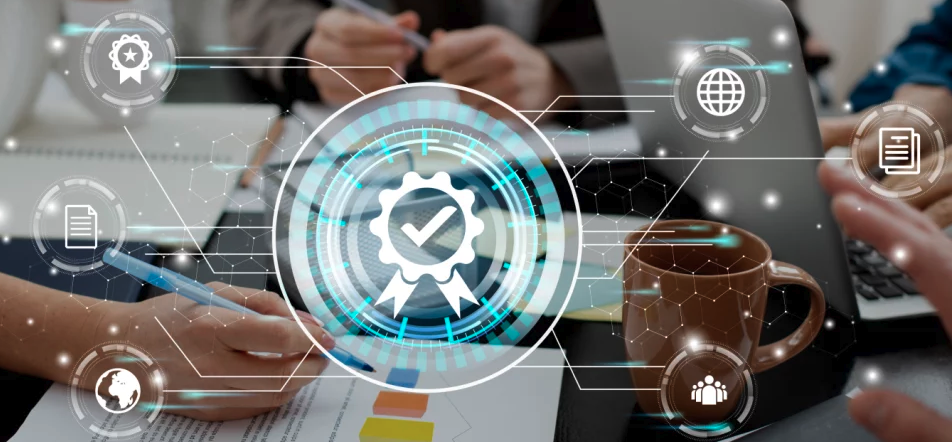
IT services trends (Image by Terralogic)

IT services trends (Image by Terralogic)
The world of IT services trends is like a constantly changing river, always flowing into new territories.
Yes, IT services trends are a place where old tech gets swapped out for new, cooler stuff that’s faster, more reliable, and way more secure.
Companies are always on the lookout for IT that can keep up with their ever-changing needs. And, here’s the deal: if you’re not keeping up with the latest tech trends, you’re basically giving your competitors a free pass to zoom ahead.
But if you’re the type to jump on the new tech bandwagon, you’re setting yourself up for some serious wins. Think of this guide as your personal GPS through the wilds of IT.
We’ll break down what they mean for you and your biz, and give you some solid tips on how to make the most of them.
So, are you ready to take a trip into the future of IT? We’re going to dive into the big trends that are shaping up to be the talk of the town in 2024. Let’s get in.
Imagine you’ve got three awesome sets of tools – artificial intelligence (AI), machine learning, and robotic process automation (RPA).
Now, merge them all together. What you get is hyper-automation.
Here’s the big deal: hyper-automation uses AI, machine learning, and RPA to take care of all those boring tasks that nobody really likes doing: the stuff that’s important but kind of repetitive.
With AI, you’ve got a system that can sift through mountains of data to find ways to make things better.
Machine learning is like the smart kid in class, always figuring out how to avoid problems before they even happen.
And RPA? Think of it as your digital helper, doing all the nitty-gritty tasks like filling out forms or cranking out reports – stuff that’s got to be done, but doesn’t really need a human touch.
Put all these together, and you’ve got a powerhouse that ramps up efficiency, cuts down mistakes, and can even save some cash on operational costs.
Hyper-automation is like giving your business a mega boost, making things run smoother and letting you scale up without breaking a sweat.
Traditional cloud setups often find it challenging to keep up with the speed and spread of real-time apps and devices all over the place.
That’s where edge computing comes into play, changing how we handle and connect data in 2024 IT Services Trends.
Edge computing is essentially about moving data processing closer to the action. Instead of sending everything off to far-off data centers, it processes data right where it’s happening.
The big win with edge computing? It’s mainly about speed. When you process data right where it’s generated, you cut down the travel time for that info, which is a game-changer for real-time applications.
Edge computing decentralizes the whole data processing scene. It shifts the action to the network’s ‘edge,’ closer to where data is created. This move brings a bunch of benefits.
You’ve got reduced latency, meaning things get done faster. There’s enhanced scalability, so your systems can grow without a hitch.
Improved security is another perk, as data doesn’t have to travel as much. And, it can even help keep costs down.
AI in IT support is like a step ahead, always thinking about what’s next. It’s not just about answering when there’s a problem; it’s about catching those problems before they even show up. Let’s break it down.
First, we’ve got AI-driven chatbots. This AI chatbot can handle loads of different questions, from simple stuff like password resets to more complex tech troubles. It’s like having a helpful IT expert available any time, any day.
Then, there’s predictive analytics – a real powerhouse in AI. This is all about digging into heaps of data to spot issues before they become headaches for users.
It’s like having a crystal ball that shows you where the IT bumps are, so you can smooth them out before anyone even notices.
And let’s not forget about automation. AI is great at taking over those repetitive tasks – think data entry, keeping systems up-to-date, and managing configurations.
This isn’t just about saving time; it’s about making sure these routine jobs are done consistently and accurately, freeing up your IT folks to focus on the big-picture stuff.
So, essentially, AI is reshaping IT support and operations. By blending smart chatbots, predictive analytics, and automation, it’s turning IT support into something quicker, more forward-thinking, and efficient.
Unfortunately, the landscape of cyber threats is constantly evolving, with attackers developing ever more sophisticated techniques to exploit vulnerabilities and gain access to sensitive information as one of important services trends.
These cybercriminals aren’t taking breaks. They’re always hunting for new weak spots and figuring out how to sneak past the usual security measures.
Some of the key trends shaping the current threat are utilizing artificial intelligence (AI) and machine learning (ML) to target attacks in super specific ways.
They’re also pretty good at social engineering – tricking people into giving up information.
We also see exploitation of zero-day vulnerabilities, rise of ransomware, and supply chain attacks.
The old-school way of just looking for known viruses isn’t enough anymore.
Business need to level up their security game with tools that can spot and stop attacks as they’re happening. This includes:
Then, we must have zero-trust architectures. It might sound tough, but it’s really smart.
Basically, it doesn’t automatically trust anyone or anything, whether it’s inside or outside the network. Every request for access is treated with suspicion.
And definitely, we can’t forget about AI in cybersecurity. AI is like the super smart sidekick, always learning new tricks to catch threats.
It’s great at picking up on weird patterns or behaviors that might be a sign of a cyberattack as one of important things for 2024 IT services trends.

Cloud-native innovations are really shaking things up in the IT services trends. This innovation makes everything more flexible, scalable, and quick to adapt.
And it’s a big deal considering how fast technology is moving these days. Let’s dive into some of the cool trends in cloud-native tech for 2024.
One of the most exciting trends in cloud computing is the rise of serverless computing.
This approach allows developers to build and deploy applications without having to manage or provision servers, significantly increasing agility and reducing operational costs.
As cloud-native apps get more complex, there’s a growing need for smart ways to manage them. Kubernetes is leading the pack here.
Kubernetes is an open-source platform that takes the headache out of managing containerized apps.
Kubernetes makes sure everything works in harmony, especially when you’re juggling a lot of different components, like with microservices.
And speaking of microservices, they’re another big trend. Instead of creating one giant application, you build a bunch of smaller, independent services.
It’s like having a team of experts, each doing their own thing but working towards the same goal. This makes updating and scaling your applications a breeze.
So, what’s the takeaway for businesses and IT teams? We’re moving towards IT solutions that are more agile and responsive.
While still in its nascent stages, quantum computing presents a future where data processing and problem-solving transcend current limitations, impacting every facet of IT services.
So, why is everyone talking about quantum computing? Well, it’s because it deals with information in a totally different way than traditional computing.
Regular computers work with bits – think of them as simple on/off switches.Quantum computers, on the other hand, use something called qubits.
These qubits are special because, thanks to the quirks of quantum mechanics, they can be on, off, or both at the same time.
This ability, along with a cool thing called entanglement (where qubits can be connected no matter how far apart they are), lets quantum computers do calculations in parallel.
This means they can handle complex problems super fast, way faster than today’s computers.
For businesses, getting a grip on quantum computing early could be a huge advantage. It’s not just about being ready for a new type of computer.
Preparing for quantum computing means being ready to take advantage of a whole new level of computing power.
Think of AR and VR as a bridge between the digital and physical worlds. AR (Augmented Reality) adds digital elements to a live view.
VR (Virtual Reality), on the other hand, is all about creating a fully immersive experience that transports you to another world entirely.
How does this apply to IT services? One big area is remote support. As AR and VR continue to evolve, their impact on IT services will be profound, changing the way we work, learn, and interact with the world around us.
With AR, someone can get help in real time, with digital instructions overlaid on their actual environment. It’s like having a helpful guide right in front of you, showing you exactly what to do.
Training is another area where AR and VR are making waves. Imagine learning a new skill or going through a safety drill in a completely controlled, virtual environment. It’s safe, efficient, and can be much more engaging than traditional methods.
Then there are immersive user experiences. This is where companies can really get creative, using AR and VR to give customers a unique, engaging way to explore products or services.
Green and sustainable IT is about using tech in a way that’s kind to the environment. Think cutting down on how much power we use, picking materials that are better for the earth, and recycling our gadgets the right way.
And it’s not just the big stuff. Being eco-friendly with IT can be as simple as going more digital to cut down on paper, or making sure we recycle our old phones and laptops properly.
Energy-efficient data centers are another big piece of the puzzle. These centers are like the engine room of the internet, and they can use a lot of energy.
Finding ways to make them use less power is key. This might mean cooler cooling systems, switching to renewable energy, or coming up with designs that naturally use less power.
Sustainable IT is about making choices that are both smart and good for the environment. Whether we’re talking about huge data centers or the phone in your pocket, it’s about being mindful of how our tech choices affect the world around us.
Heading into 2024, the world of IT services is not just about flashy new gadgets and software.
It’s more like we’re at the doorstep of a whole new way of doing business and interacting with technology.
It’s kind of like when smartphones first came out. Suddenly, everything changed – how we communicate, shop, work, you name it.
In the same way, the advancements in IT are reshaping the business landscape. We’re talking about changes that go deeper than just upgrading to the latest tech.
Businesses that get on board with these trends, that really embrace and adapt to this new world, are setting themselves up for some exciting times. It’s not just about keeping up; it’s about being part of the innovation wave.
Imagine being able to solve problems faster with AI, connect with customers in more engaging ways using AR and VR, and even make smarter decisions with data analytics.
That’s why your business requires a support system that facilitates IT change management down to the smallest detail.
And let’s not forget about the importance of sustainable IT practices. It’s about being responsible and forward-thinking in how we use technology.
So, as we move forward, it’s not just about what technology can do; it’s about how it changes the way we do business.